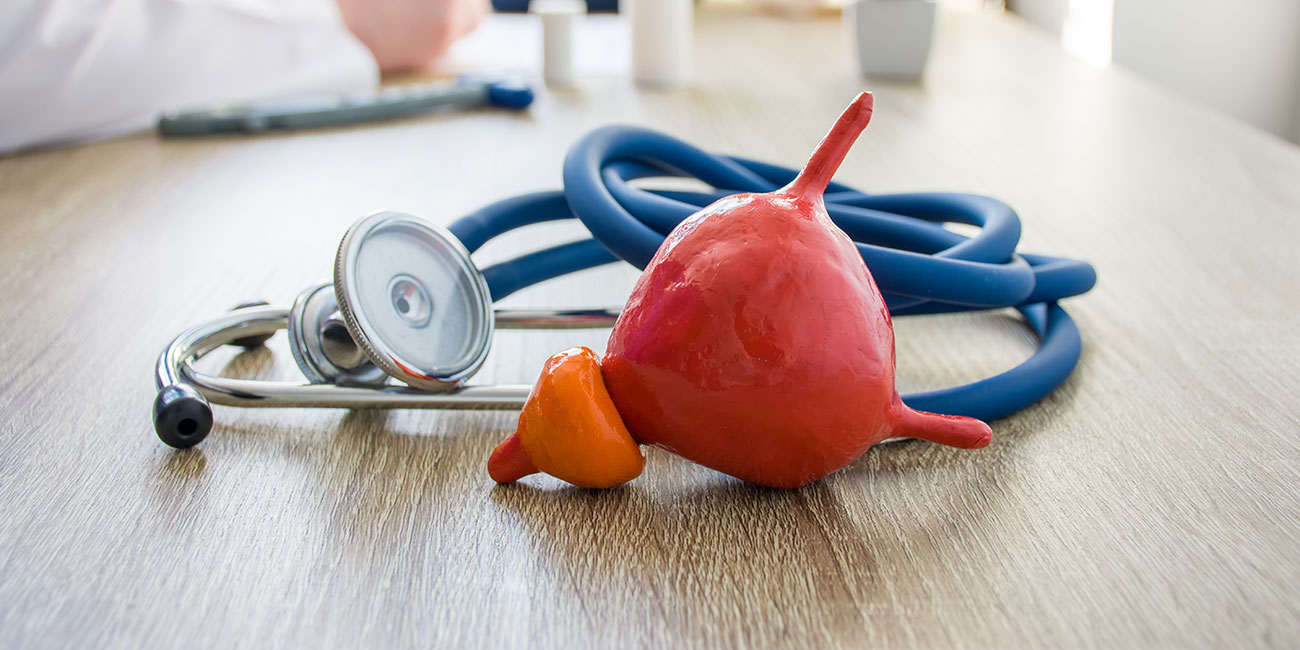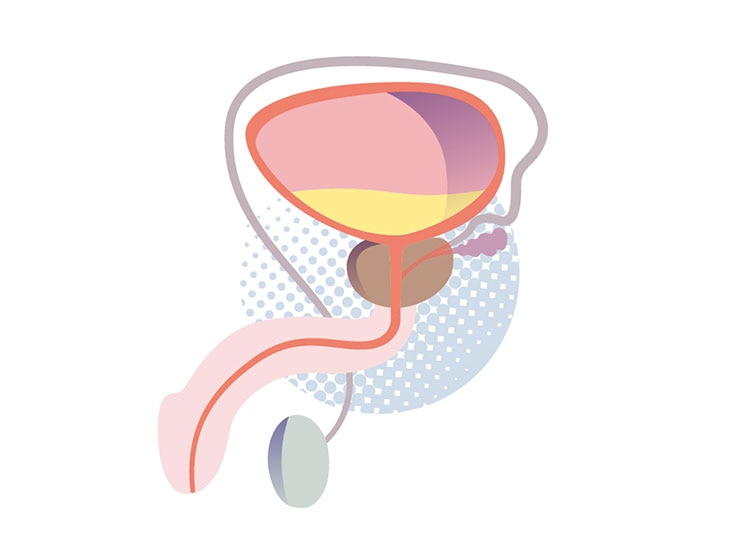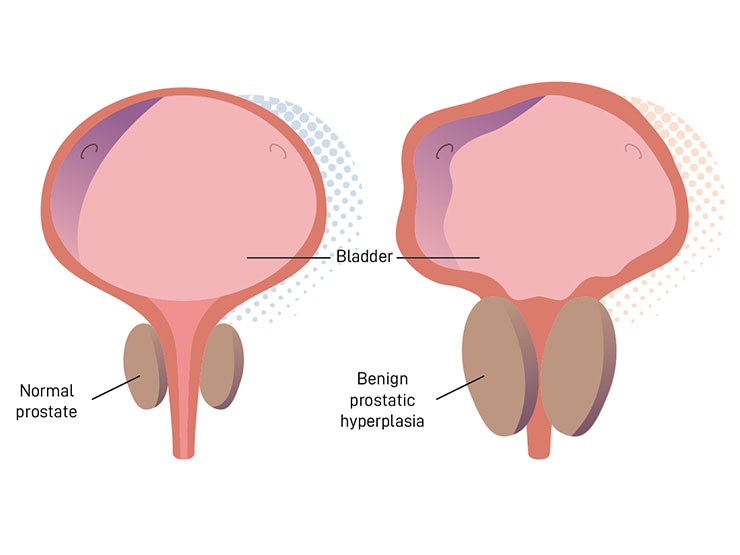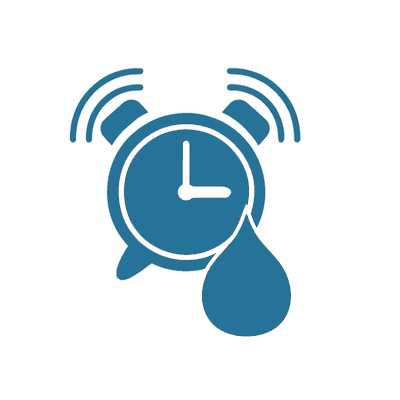
About prostate cancer

What is the prostate?
The prostate gland is approximately the size of a large chestnut, with two lateral lobes, right and left, and covered by a thin layer of cells or capsule, which separates it from the fat that surrounds it. It is located behind the base of the penis and the pubis, in front of the rectum or/and below the bladder.
Its purpose is to secrete components of semen. It is also a crossroads between the urethra coming from the bladder and the vas deferens coming from the testicles and draining the seminal vesicles (small glands located high behind the prostate, between the bladder and the rectum).

The size of the prostate varies over the years in men. An increase in size is common due to benign cell growth, which is called benign prostate hypertrophy (BPH). The urethra passes through the middle of the prostate, so an enlarged prostate can cause difficulties to urinate due to the narrowing of the urethra and requires medical treatment. In cases with large volumes, a small intervention may be necessary to enlarge the diameter of the urethra, called a transurethral resection or TURP. This increase in size does not imply the presence of any cancer.
The seminal vesicles are two glands that store seminal fluid and are located just on top your prostate gland.
All biological organisms including plants and animals are made up of tiny components called cells. Each cell has a biological code called DNA and this code is organised into a series of genes which contain the information needed for the organism to function and also determine a variety of the organisms’ characteristics including height, weight, eye colour, skin colour and the timing for cells to divide or to stop dividing.
Each organism begins as a single cell, and multiplies by giving birth to new cells, and then either stops dividing at some point or dies based on its built-in genetic code. All of the information contained in the genes is passed on to descendant cells. Certain genes may have mutations or mistakes in their building blocks which may cause the cell's working program to be disrupted and cause it to behave abnormally. These abnormalities are either naturally corrected by the body’s fail-safe mechanisms (immune system) or they can cause the cell to die spontaneously.

However, these cells with abnormal instructions do sometimes survive and keep on dividing in an uncontrolled manner leading to tumorous growths which may be benign (non-cancerous) or malignant (cancerous).
Cancer is a disease triggered by a cell having its program disrupted and changing leading it to multiply uncontrollably. These out-of-control cells gradually combine into a malignant, or cancerous, tumour. Sometimes, cancer cells will invade neighbouring tissues and grow in new areas of the body. They can spread across blood and lymph vessels and form other tumours at a distance, which are then known as metastases.
When cells in the prostate gland develop abnormally, they form a tumor, this is called prostate cancer. Prostate cancer develops slowly in most cases, so today it is usually diagnosed when it is present only within the prostate gland, which is known as early, localized, or organ-confined prostate cancer. Most often there are no signs of prostate cancer in its early stages, and if you have urinary discomfort, it may be due to benign causes. A PSA test (blood test) or an abnormal digital exam might be the only way your doctor can detect it. In more aggressive cases, it can grow rapidly and spread to other areas of the body, mainly the bones.


Locally advanced prostate cancer occurs when the cancer has burst through the capsule (covering) of the prostate gland or has spread beyond the gland to surrounding tissues. Tissues such as your seminal vesicles, regional lymph nodes (limited to the pelvic lymph nodes), bladder neck, and back passage are all places where cancer can spread (rectum).
Prostate cancer that has spread to other areas of the body, away from the prostate gland and its regional lymphatic system, is known as metastatic prostate cancer.
Although prostate cancer is the second leading cause of death in men, if caught in the early stages, the 5-year survival rate is extremely good. As a result, significant research has been done into new and more innovative ways to diagnose and treat this disease.
Nowadays, most prostate cancers are diagnosed in early stages, and they grow slowly, so a curative treatment can be given and there is not usually life risk unlike with other types of cancer.
The lymphatic system defends us against illness and infection.
It drains extracellular liquids that contains waste from cells and is used by the white cells to continuously search for disease or abnormalities.
Lymph vessels are in almost every organ (except central nervous system). You can find lymphatic vessels in muscles, in lungs … and in the prostate. These Lymph vessels connect to lymph nodes.
Lymph node clusters are located in different places in the body. The throat, armpit, groin, and abdomen are the most common locations for lymph nodes. These node clusters are well known and swollen in the area near an infection (for example in the strep throat, with swollen lymph nodes in the neck).
That is the reason why when a cancer cell “leaves” the primary tumor, it is transported by the flow of the extracellular liquid, then in the lymph vessels that drains the tumor and they usually spread to the first place where the flow leads them: to the lymph nodes. The lymph nodes swell because of this.

Prostate cancer's exact cause is unclear. However, certain factors known as risk factors can influence your chances of developing a tumour. Having a risk factor does not guarantee that you will develop cancer. Cancer may also strike people who have no established risk factors. Prostate cancer can be caused by a number of factors, including:
Factors of Cancer
Race:
Afro-Caribbean men have a higher risk of prostate cancer than white men. It's important to remember that prostate cancer is not contagious and cannot be passed on to anyone.
Age:
Prostate cancer risk rises as people get older. Men over the age of 50 are more likely to be affected, while men under the age of 50 are less likely to be affected. Prostate cancer is diagnosed in about two out of every three men over the age of 65.
Genetic disorders:
If you have a brother or father who has the disorder, the chances are higher. If a relative was diagnosed with prostate cancer at a younger age or if you have more than one relative with the disease, the chances are even higher.
Additional risk factors
Some limited additional risk factors like diet, hormone levels, and obesity…
The following are the signs and symptoms of an enlarged prostate
![]()
Urinate
frequently
![]()
Erectile
dysfunction
![]()
Pain
or stiffness in lower back and hips

Blood
in urine or semen
![]()
Burning
sensation when urinating
![]()
Painful
ejaculation
![]()
Difficulty
starting to urinate

Warning
Consult a physician as soon as possible if you experience any of these symptoms
Prostate cancer diagnosis

Urinate Frequently
Urination is required on a regular basis and more frequently than usual, particularly at night (nycturia).
- Stream of urine is weak.
- A sensation of not being able to fully empty one's bladder.
- Urinary incontinence (urinary leakage).
- Chronic prostatitis
- Urinary retention or difficulty or inability to urinate.

Erectile dysfunction
Obtaining an erection is difficult.

Pain
Pain or stiffness in lower back and hips.

Blood
Blood in Urine or semen

Burning sensation when urinating

Painful ejaculation
- Obtaining an erection is difficult.
- When ejaculating, there is discomfort.

Difficulty starting to urinate
- Urinary retention or difficulty or inability to urinate.

Consult a physician
Consult a physician as soon as possible if you experience any of these symptoms
-
- Stream of urine is weak.
- A sensation of not being able to fully empty one's bladder.
- Urinary incontinence (urinary leakage).
- Chronic prostatitis
- Urinary retention or difficulty or inability to urinate.
- Urine or sperm with blood.
- Obtaining an erection is difficult.
- When ejaculating, there is discomfort.
Contact Support

